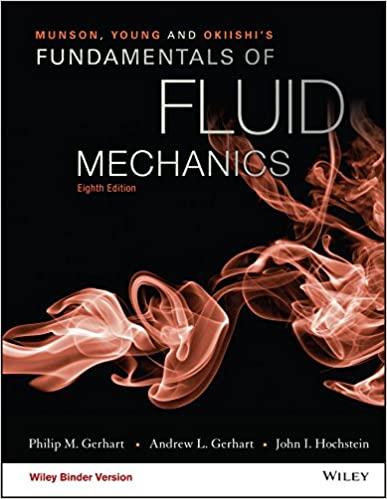A thief siphoned (15 mathrm{gal}) of gasoline from a gas tank in the middle of the night.
Question:
A thief siphoned \(15 \mathrm{gal}\) of gasoline from a gas tank in the middle of the night. The gas tank is \(12 \mathrm{in}\). wide, \(24 \mathrm{in}\). long, and 18 in. high and was full when the thief started. The siphoning plastic tube has an inside diameter of \(0.5 \mathrm{in}\). and a length of \(4.0 \mathrm{ft}\). Assume that at any instant of time, the steady-state mechanical energy equation is adequate to predict the gasoline flow rate through the tube. As 15 gal is \(3465 \mathrm{in}^{3}\), the gasoline level in the tank will drop 12.0 in. You may use the gasoline level after it has dropped 6.0 in. to estimate the average gasoline flow rate. Use this flow rate to estimate the time needed to siphon the \(15 \mathrm{gal}\) of gasoline. Compare your answer with the answer of \(190 \mathrm{sec}\) found in problem 3.107, using Bernoulli's equation. The siphon discharges at the level of the bottom of the gasoline tank. You may find it useful to use the Blasius equation for smooth pipes found in problem 8.45.
Problem 8.45
H. Blasius correlated data on turbulent friction factor in smooth pipes. His equation \(f_{\text {smooth }} \approx 0.3164 \mathrm{Re}^{-1 / 4}\) is reasonably accurate for Reynolds numbers between 4000 and \(10^{5}\). Use this information for the following scenario. Water at \(20{ }^{\circ} \mathrm{C}\) is to flow through a \(3-\mathrm{cm}\) I.D. plastic pipe at the rate of \(0.001 \mathrm{~m}^{3} / \mathrm{s}\). Find the incline angle of the pipe needed to make the static pressure constant along the pipe.
Step by Step Answer:

Munson Young And Okiishi's Fundamentals Of Fluid Mechanics
ISBN: 9781119080701
8th Edition
Authors: Philip M. Gerhart, Andrew L. Gerhart, John I. Hochstein





